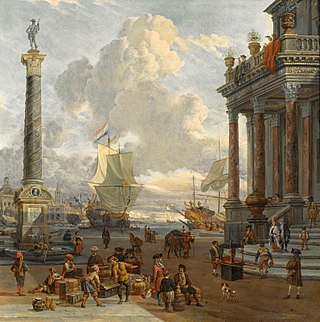Related Research Articles

The economy of Armenia grew by 12.6% in 2022, according to the country's Statistical Committee and the International Monetary Fund. Total output amounted to 8.5 trillion Armenian drams, or $19.5 billion. At the same time, Armenia's foreign trade turnover significantly accelerated in growth from 17.7% in 2021 to 68.6% in 2022. GDP contracted sharply in 2020 by 7.2%, mainly due to the COVID-19 recession and the war against Azerbaijan. In contrast it grew by 7.6 per cent in 2019, the largest recorded growth since 2007, while between 2012 and 2018 GDP grew 40.7%, and key banking indicators like assets and credit exposures almost doubled.

The economy of Georgia is an emerging free market economy. Its gross domestic product fell sharply following the dissolution of the Soviet Union but recovered in the mid-2000s, growing in double digits thanks to the economic and democratic reforms brought by the peaceful Rose Revolution. Georgia continued its economic progress since, "moving from a near-failed state in 2003 to a relatively well-functioning market economy in 2014". In 2007, the World Bank named Georgia the World's number one economic reformer, and has consistently ranked the country at the top of its ease of doing business index.

The economy of Mongolia has traditionally been based on agriculture and livestock. Mongolia also has extensive mineral deposits: copper, coal, molybdenum, tin, tungsten, and gold account for a large part of industrial production. Soviet assistance, at its height one-third of Gross domestic product (GDP), disappeared almost overnight in 1990–91, in the time of the collapse of the Soviet Union. Mongolia was driven into deep recession.

The economy of Russia has gradually transformed from a planned economy into a mixed market-oriented economy. It has enormous natural resources, particularly oil and natural gas. In 2023, it was the world's 11th-largest economy by nominal GDP, and 6th-largest by purchasing power parity (PPP) according to IMF, 5th-largest according to World Bank. Due to a volatile currency exchange rate, Russia's GDP as measured in dollars fluctuates sharply. Russia was the last major economy to join the WTO, becoming a member in 2012.

The economy of Ukraine is an emerging, lower-middle income, mixed economy located in Eastern Europe. It grew rapidly from 2000 until 2008 when the Great Recession began worldwide and reached Ukraine. The economy recovered in 2010 and continued improving until 2013. From 2014 to 2015, the Ukrainian economy suffered a severe downturn, with GDP in 2015 being slightly above half of its value in 2013. In 2016, the economy again started to grow. By 2018, the Ukrainian economy was growing rapidly, and reached almost 80% of its size in 2008.

The United Arab Emirates is a high-income developing market economy. The UAE's economy is the 2nd largest in the Middle East, with a gross domestic product (GDP) of US$415 billion in 2021-2023.

The arms industry, also known as the defense industry, military industry, or the arms trade, is a global industry which manufactures and sells weapons and military technology. Public sector and private sector firms conduct research and development, engineering, production, and servicing of military material, equipment, and facilities. Customers are the armed forces of states, and civilians. An arsenal is a place where arms and ammunition – whether privately or publicly owned – are made, maintained and repaired, stored, or issued, in any combination. Products of the arms industry include weapons, munitions, weapons platforms, military communications and other electronics, and more. The arms industry also provides other logistical and operational support.

Non-tariff barriers to trade are trade barriers that restrict imports or exports of goods or services through mechanisms other than the simple imposition of tariffs. Such barriers are subject to controversy and debate, as they may comply with international rules on trade yet serve protectionist purposes.

The International Trade Centre (ITC) is a multilateral agency which has a joint mandate with the World Trade Organization (WTO) and the United Nations (UN) through the United Nations Conference on Trade and Development (UNCTAD).

Algeria's economy continued to recover in the first half of 2022, led by a return of oil production to pre-pandemic levels and a continued recovery of the service sector along with a more vigorous agricultural activity. The recovery should continue into 2023, supported by the nonhydrocarbon sector and public expenditure growth, according to the latest edition of the World Bank's Algeria Economic Update.

Kenya–Russia relations are bilateral relations between Kenya and Russia. Russia had established diplomatic relations with Kenya on December 14, 1963, and has since maintained good relations with the African Great Lakes country.

The Observatory of Economic Complexity (OEC) is a data visualization site for international trade data created by the Macro Connections group at the MIT Media Lab. The goal of the observatory is to distribute international trade data in a visual form. At present the observatory serves more than 20 million interactive visualizations, connecting hundreds of countries to their export destinations and to the products that they trade.